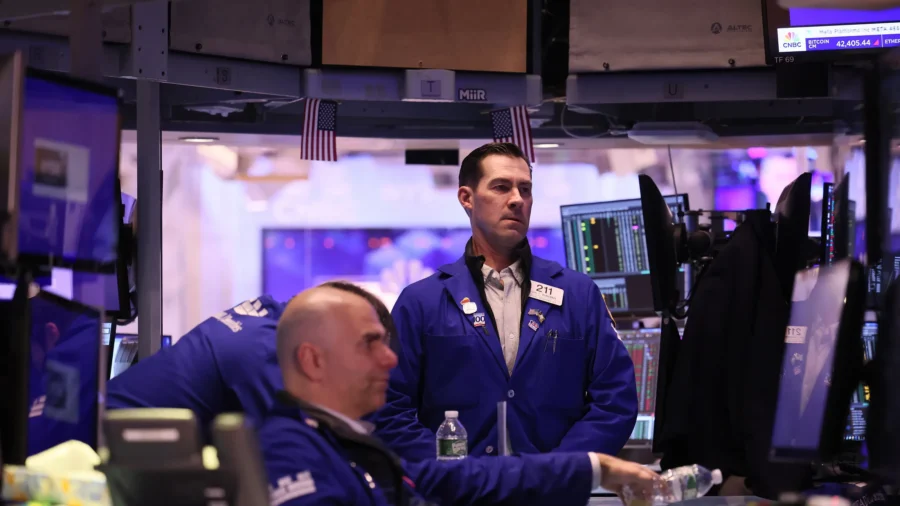An official with JPMorgan Chase warned that while U.S. stocks hit record highs recently, that momentum may not continue and will raise risks of a 1970s-style “stagflation” scenario.
A chief market strategist with the top U.S. bank, Marko Kolanovic, warned there appears to be too much optimism about the current market. The Federal Reserve has continued to keep interest rates high, while inflation numbers reported for January 2024 came in higher than anticipated.
For the past several months, analysts at other top banks such as Goldman Sachs and surveys of CEOs have signaled that banks have expected the U.S. economy to avoid a recession. That came after there were a number of warnings that an economic downturn would occur due to elevated inflation combined with the after-effects of the COVID-19 pandemic, lockdowns, and other restrictions.
“We believe that there is a risk of the narrative turning back from goldilocks towards something like 1970s stagflation, with significant implications for asset allocation,” Mr. Kolanovic said in a recent note, according to multiple media reports.
He then asked: “Can one get inflation under control with stock and crypto markets adding trillions of paper wealth, and tightening aspects of [central banks’ selling assets] neutralized by Treasury issuance? For instance, just one tech company’s recent gains added the equivalent of the market capitalization of the bottom 100 companies in the S&P 500, and the size of the crypto market doubled since last fall. Can the Fed lower inflation with these developments that are loosening monetary conditions?”
The analyst also made reference to high amounts of immigration and elevated U.S. government spending.
“With the Nasdaq index rallying [approximately 70 percent] in a year, tight labor markets, and high immigration and government fiscal spending, it wouldn’t be a surprise that inflation may stop declining or move higher,” he wrote.
Another risk he evaluated is whether geopolitical developments as well as the U.S. presidential elections could increase risk for global trade.
“Our view is that there is likely no market upside related to the U.S. election, as the outcome is either status quo or increased uncertainty related to global trade and geopolitical/domestic tensions,” Mr. Kolanovic added. “Investor positioning has increased significantly and presents an increasing headwind for the market.”
Investors who don’t believe there will be a recession or stagflation—or when an economy has high unemployment, high inflation, and poor economic growth—may be “basing their constructive market call on the premise that corporate profits are set to accelerate, but the earnings reality might turn out to be the opposite as we move through the year,” according to reports.
“Corporate profit margins are elevated in a historical context, and appear to be peaking out. Historically, profit margins always start to move lower ahead of the next economic downturn,” he said.
Other Warnings
Like Mr. Kolanovic, JPMorgan CEO Jamie Dimon has pointed out there are similarities between this year and the 1970s, noting large fiscal deficits, large amounts of government spending, and changes in global trade.
“I’m a little skeptical of this kind of ‘Goldilocks’ kind of scenario,” he told Fox Business in late December.
“It might be [a] mild recession or heavy recession,” Mr. Dimon said, noting the persistence of inflationary factors like the Biden administration’s massive borrow-and-spend initiatives and rejigging of supply chains as globalization unwinds, which threaten to lead to stagflation—a dreaded double-whammy of economic contraction plus high inflation.
Last month, the CEO issued another warning about a possible recession in the coming months due to a huge deficit the government is running and that pandemic-related money that was issued is running out.
“It might be [a] mild recession or heavy recession,” Mr. Dimon said.
Elaborating, he said, “I look at a lot of things—and forget just economic models for a second—$2 trillion of fiscal deficit, the infrastructure, and IRA [Inflation Reduction Act] act, the green economy, the re-militarization of the world, the restructuring of trade are all inflationary … and that looks a little more like the 1970s to me.”
Too Dire?
But the Conference Board last week abandoned a long-running call for the U.S. economy to fall into recession, although its Leading Economic Index still sees economic output flatlining in the months ahead.
The business research group’s index, meant to be a gauge of future economic activity, fell 0.4 percent in January to 102.7, the lowest level since April 2020 when the United States was in a brief recession after the onset of the COVID-19 pandemic and related shutdowns.
It was the 23rd straight monthly decline, just one month short of the record-long slump that began in April 2007 and ran through March 2009 during the global financial crisis.
“While the declining LEI continues to signal headwinds to economic activity, for the first time in the past two years, six out of its 10 components were positive contributors over the past six-month period,” said Justyna Zabinska-La Monica, senior manager, business cycle indicators at the Conference Board. “As a result, the leading index currently does not signal recession ahead.”
Reuters contributed to this report.
From The Epoch Times


